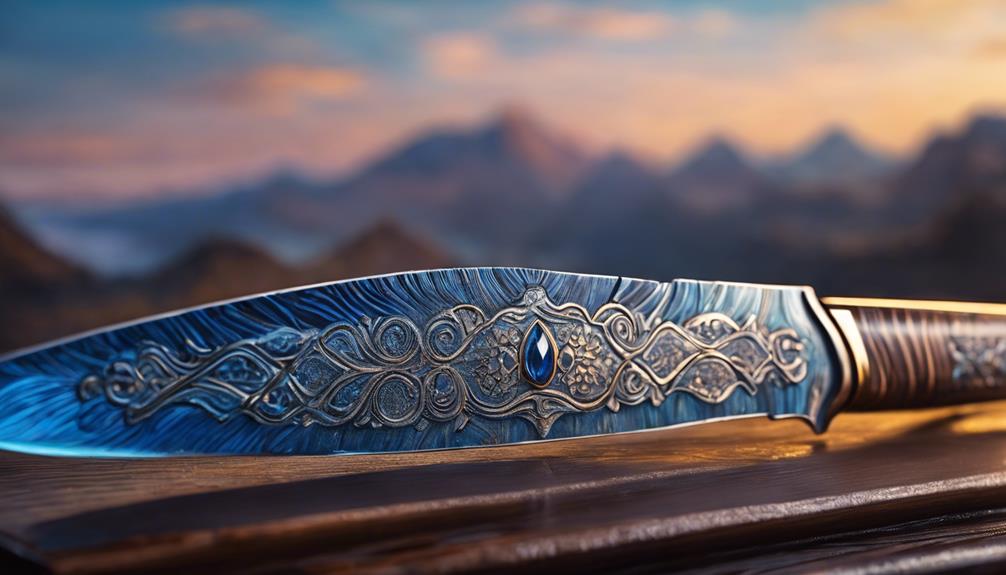Damascus steel is highly regarded for its extraordinary strength, durability, and striking patterns, making it popular for high-performance tools and luxury knives. It is resistant to wear and corrosion, adding to its longevity and aesthetic appeal. Nevertheless, it requires careful maintenance to prevent rust and can be brittle under stress, leading to potential chipping. The manufacturing process is labor-intensive, resulting in higher costs that may deter budget-conscious consumers. Additionally, variations in artisan techniques can affect quality consistency. For a deeper understanding of how Damascus steel compares to other materials and its ideal applications, more knowledge awaits.
Main Points
- Damascus steel is renowned for its strength and durability, making it ideal for high-performance tools and weapons.
- Its unique manufacturing process enhances toughness while ensuring a sharp edge and distinctive patterns.
- While it offers impressive corrosion resistance, Damascus steel can rust if not properly maintained.
- The labor-intensive production leads to higher costs, which may be a drawback for budget-conscious consumers.
Advantages of Damascus Steel
One of the primary advantages of Damascus steel is its extraordinary strength and durability, making it an ideal material for high-performance tools and weapons. The unique manufacturing process, which involves the folding and forge-welding of various steel types, results in a composite structure that improves toughness while maintaining sharpness. This characteristic is particularly beneficial for blades, where edge retention is essential for effective performance.
Moreover, Damascus steel exhibits an impressive resistance to corrosion and wear, which extends the lifespan of products made from it. This resilience is attributed to the high carbon content and carefully selected alloying elements that contribute to its overall sturdiness.
Additionally, the aesthetic appeal of Damascus steel cannot be overlooked; the distinctive patterns formed during the forging process not only improve its visual attractiveness but also signify the craftsmanship involved in its production.
Furthermore, Damascus steel offers versatility in application, being suitable for a wide range of tools, from kitchen knives to outdoor gear. As a result, its combination of strength, durability, aesthetic appeal, and versatility makes it a sought-after material for both functional and decorative items in various industries.
Disadvantages of Damascus Steel
Despite its many advantages, Damascus steel also has notable disadvantages that can impact its practicality and usability in various applications.
One considerable drawback is its susceptibility to corrosion, particularly if not properly maintained. The layered structure, while aesthetically appealing, can create pockets that trap moisture and lead to rust if the surface is not adequately treated.
Additionally, the manufacturing process of Damascus steel can be labor-intensive and time-consuming, resulting in higher production costs. This can make products made from Damascus steel less accessible for budget-conscious consumers. Furthermore, inconsistencies in quality can arise depending on the specific techniques and materials used by different artisans, leading to variability in performance and durability.
Another consideration is that while Damascus steel is renowned for its sharpness and edge retention, its hardness can also make it more brittle compared to other steels. This can result in chipping or cracking under extreme stress or when used for heavy-duty applications.
Comparison With Other Materials
When evaluating Damascus steel, it is important to compare its properties and performance with those of other materials commonly used in similar applications, such as high-carbon steel and stainless steel.
Damascus steel is renowned for its striking aesthetic and unique patterns, resulting from the forge-welding of multiple steel layers. This process not only improves its visual appeal but also contributes to a balance of strength and flexibility, making it a highly sought-after material for knives and swords.
In contrast, high-carbon steel is known for its superior hardness and edge retention, making it ideal for tools and cutting implements. Nevertheless, it is more susceptible to rust and corrosion, requiring diligent maintenance.
Stainless steel, on the other hand, offers excellent corrosion resistance and is low-maintenance, but often lacks the edge retention and sharpness of high-carbon and Damascus steels.
Ultimately, the choice between these materials depends on the intended use and user preferences. While Damascus steel offers a unique blend of beauty and performance, high-carbon and stainless steels excel in specific applications, each presenting advantages and trade-offs that must be carefully considered.
Common Questions
How Is Damascus Steel Made?
Damascus steel is produced by layering different types of steel and iron, then forge-welding them together. This process creates a distinctive pattern and improves the material's strength and durability through repeated folding and shaping.
Is Damascus Steel Rust-Resistant?
Damascus steel exhibits varying degrees of rust resistance, largely dependent on its composition. Generally, higher-quality Damascus steel incorporates stainless elements, enhancing its resistance to corrosion, while lower-grade versions may be more susceptible to rust.
Can Damascus Steel Be Sharpened Easily?
Damascus steel can be sharpened relatively easily due to its unique layered structure, which allows for effective honing. Nevertheless, the specific sharpening process may depend on the type of steel and its intended use.
What Are Common Uses for Damascus Steel?
Common uses for Damascus steel include high-end knives, swords, and other cutting tools, where its unique patterns and durability improve aesthetic appeal and performance. It is also employed in art pieces and decorative items.
Does Damascus Steel Have a Specific Origin?
Damascus steel originated in the Near East, particularly in regions such as Syria and India, during the 3rd century. Its unique production techniques and distinctive patterns contributed to its historical significance in weaponry and craftsmanship.
Conclusion
In summary, Damascus steel presents a unique blend of advantages and disadvantages that merit consideration.
Its aesthetic appeal, strength, and edge retention are noteworthy benefits, making it a popular choice for knives and tools.
Nonetheless, issues related to cost, maintenance, and susceptibility to corrosion cannot be overlooked.
When compared to other materials, such as stainless steel and carbon steel, Damascus steel offers distinct characteristics that may align with specific user preferences and applications.
